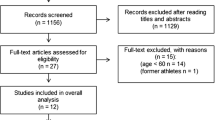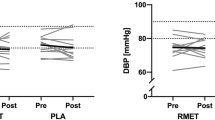Abstract
Purpose
One of the most important consequences of smoking is the development of cardiovascular diseases. However, little is known about the early consequences of smoking and the acute effects of a single inspiratory muscle exercise session (IME). We evaluated the acute effects of an IME on cardiac parameters of young smokers.
Methods
Twelve nonsmokers (C) and fifteen smokers [S; 2.08 (1.0–3.2) pack-years] underwent an acute IME. We evaluated blood pressure (BP) and lactate, and we recorded RR interval for posterior analysis of heart rate variability (HRV), before and after IME.
Results
At baseline, systolic BP and HRV parameters in time and frequency domains were changed in S group in comparison with the C. Following IME, S group reduced systolic BP (−8 %), low frequency band (LF) (−21.4 %), LF/high frequency (HF) (−57 %), as well as increased RR variance (+105 %) and HF band.
Conclusions
Our findings indicate that a single session of inspiratory muscle exercise was able to both reduce systolic BP and improve parasympathetic and sympathetic modulations in young smokers. The results of the current study highlight the importance of furthering research on this area to better elucidate the acute and chronic effects of inspiratory muscle training on early cardiovascular and pulmonary changes of cigarette smoking.


Similar content being viewed by others
References
World Health Organization (2011) WHO report on the global tobacco epidemic, 2011: implementing smoke-free environments (online). http://www.who.int/tobacco/global_report/2011/en/index.html
Katz A, Grosbard A (2006) Does it all go up in smoke? Cigarette smoking and tachyarrhythmia. J Cardiovasc Electrophysiol 17:937–939. doi:10.1111/j.1540-8167.2006.00573.x
Hanna ST (2006) Nicotine effect on cardiovascular system and ion channels. J Cardiovasc Pharmacol 47:348–358. doi:10.1097/01.fjc.0000205984.13395.9e
Adamopoulos D, Van de Borne P, Argacha JF (2008) New insights into the sympathetic, endothelial and coronary effects of nicotine. Clin Exp Pharmacol Physiol 35:458–463. doi:10.1111/j.1440-1681.2008.04896.x
Carlsson S, Midthjell K, Grill V, Nord-Trøndelagstudy (2004) Smoking is associated with an increased risk of type 2 diabetes but a decreased risk of autoimmune diabetes in adults: an 11-year follow-up of incidence of diabetes in the Nord-Trøndelag study. Diabetologia 47:1953–1956. doi:10.1007/s00125-004-1554-9
Foy CG, Bell RA, Farmer DF, Goff DC Jr, LE Wagenknecht (2005) Smoking and incidence of diabetes among U.S. adults: findings from the Insulin Resistance Atherosclerosis Study. Diabetes Care 28:2501–2507. doi:10.2337/diacare.28.10.2501
Willi C, Bodenmann P, Ghali WA, Faris PD, Cornuz J (2007) Active smoking and the risk of type 2 diabetes: a systematic review and meta-analysis. JAMA 298:2654–2664. doi:10.1001/jama.298.22.2654
Zhu B, Parmley WW (1995) Hemodynamic and vascular effects of active and passive smoking. Am Heart J 130:1270–1275
Narkiewicz K, van de Borne PJ, Hausberg M, Cooley RL, Winniford MD, Davison DE, Somers VK (1998) Cigarette smoking increases sympathetic outflow in humans. Circulation 98:528–534. doi:10.1161/01.CIR.98.6.528
Goldenberg I, Moss AJ, McNitt S, Zareba W, Daubert JP, Hall WJ, Multicenter Andrews ML, Automatic Defibrillator Implantation Trial-II Investigators (2006) Cigarette smoking and the risk of supraventricular and ventricular tachyarrhythmias in high-risk cardiac patients with implantable cardioverter defibrillators. J Cardiovasc Electrophysiol 17:931–936. doi:10.1111/j.1540-8167.2006.00526.x
Grassi G, Seravalle G, Calhoun DA, Bolla GB, Giannattasio C, Marabini M, Del Bo A, Mancia G (1994) Mechanisms responsible for sympathetic activation by cigarette smoking in humans. Circulation 90:248–253. doi:10.1161/01.CIR.90.1.248
Masuo K, Mikami H, Ogihara T, Tuck ML (1997) Sympathetic nerve hyperactivity precedes hyperinsulinemia and blood pressure elevation in a young, nonobese Japanese population. Am J Hypertens 10:77–83
Esler M, Straznicky N, Eikelis N, Masuo K, Lambert G, Lambert E (2006) Mechanisms of sympathetic activation in obesity-related hypertension. Hypertension 48:787–796. doi:10.1161/01.HYP.0000242642.42177.49
Gosselink R, De Vos J, van den Heuvel SP, Segers J, Decramer M, Kwakkel G (2011) Impact of inspiratory muscle training in patients with COPD: what is the evidence? Eur Respir J 37:416–425. doi:10.1183/09031936.00031810
Ferreira JB, Plentz RD, Stein C, Casali KR, Arena R, Lago PD (2011) Inspiratory muscle training reduces blood pressure and sympathetic activity in hypertensive patients: a randomized controlled trial. Int J Cardiol. doi:10.1016/j.ijcard.2011.09.069
Mello PR, Guerra GM, Borile S, Rondon MU, Alves MJ, Negrão CE, Dal Lago P, Mostarda C, Irigoyen MC, Consolim-Colombo FM (2012) Inspiratory muscle training reduces sympathetic nervous activity and improves inspiratory muscle weakness and quality of life in patients with chronic heart failure: a clinical trial. J Cardiopulm Rehabil Prev 32:255–261. doi:10.1097/HCR.0b013e31825828da
Chobanian AV, Bakris GL, Black HR, Cushman WC, Green LA, Izzo JL Jr, Jones DW, Materson BJ, Oparil S, Wright JT Jr, Roccella EJ, Joint National Committee on Prevention Detection, Evaluation, and Treatment of High Blood Pressure, National Heart, Lung, and Blood Institute, National High Blood Pressure Education Program Coordinating Committee (2003) Seventh report of the joint national committee on prevention, detection, evaluation, and treatment of high blood pressure. Hypertension 42:1206–1252. doi:10.1161/01.HYP.0000107251.49515.c2
Miller MR, Hankinson J, Brusasco V, Burgos F, Casaburi R, Coates A, Crapo R, Enright P, van der Grinten CP, Gustafsson P, Jensen R, Johnson DC, MacIntyre N, McKay R, Navajas D, Pedersen OF, Pellegrino R, Viegi G, Wanger J, ATS/ERS Task Force (2005) Standardisation of spirometry. Eur Respir J 26:319–338. doi:10.1183/09031936.05.00034805
Malliani A, Pagani M, Lombardi F, Cerutti S (1991) Cardiovascular neural regulation explored in the frequency domain. Circulation 84:482–492. doi:10.1161/01.CIR.84.2.482
Francica JV, Heeren MV, Tubaldini M, Sartori M, Mostarda C, Araujo RC, Irigoyen MC, De Angelis K (2013) Impairment on cardiovascular and autonomic adjustments to maximal isometric exercise tests in offspring of hypertensive parents. Eur J Prev Cardiol 20(3):480–485. doi:10.1177/2047487312452502
Minami J, Ishimitsu T, Matsuoka H (1999) Effects of smoking cessation on blood pressure and heart rate variability in habitual smokers. Hypertension 33:586–590. doi:10.1161/01.HYP.33.1.586
Somers VK, Mark AL, Abboud FM (1998) Potentiation of sympathetic nerve responses to hypoxia in borderline hypertensive subjects. Hypertension 11:608–612. doi:10.1161/01.HYP.11.6.608
Grossman E, Grossman A, Schein MH, Zimlichman R, Gavish B (2001) Breathing-control lowers blood pressure. J Hum Hypertens 15:263–269
Mourya M, Mahajan AS, Singh NP, Jain AK (2009) Effect of slow- and fast-breathing exercises on autonomic functions in patients with essential hypertension. J Altern Complement Med 15:711–717. doi:10.1089/acm.2008.0609
Bernardi L, Porta C, Gabutti A, Spicuzza L, Sleight P (2001) Modulatory effects of respiration. Auton Neurosci 90:47–56
Goso Y, Asanoi H, Ishise H, Kameyama T, Hirai T, Nozawa T, Takashima S, Umeno K, Inoue H (2001) Respiratory modulation of muscle sympathetic nerve activity in patients with chronic heart failure. Circulation 104:418–423. doi:10.1161/hc2901.093111
Acknowledgments
The authors thank Alex Rocha and Larissa Ribeiro for technical support.
Conflict of interest
The authors declare that they have no conflict of interest.
Author information
Authors and Affiliations
Corresponding author
Additional information
F. Rodrigues and A. A. Araujo have contributed equally to this work.
Rights and permissions
About this article
Cite this article
Rodrigues, F., Araujo, A.A., Mostarda, C.T. et al. Autonomic changes in young smokers: acute effects of inspiratory exercise. Clin Auton Res 23, 201–207 (2013). https://doi.org/10.1007/s10286-013-0202-1
Received:
Accepted:
Published:
Issue Date:
DOI: https://doi.org/10.1007/s10286-013-0202-1




